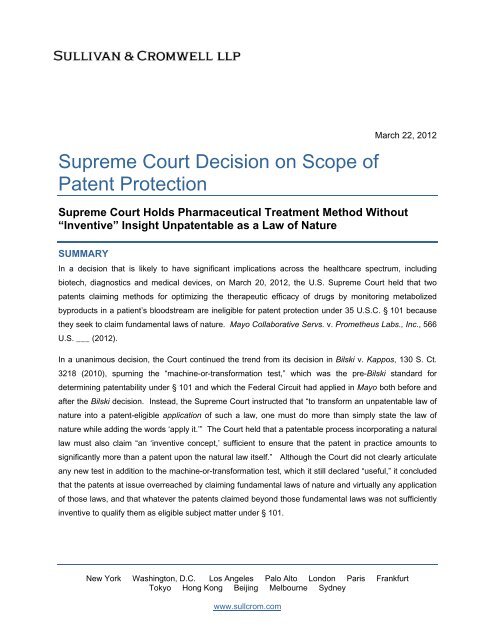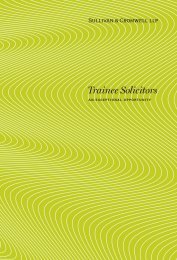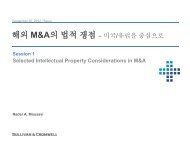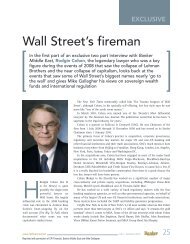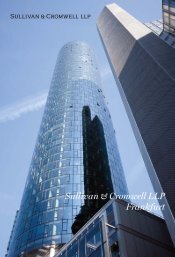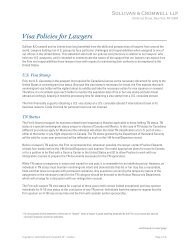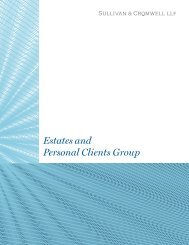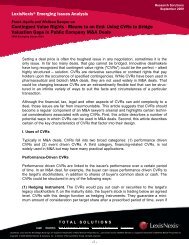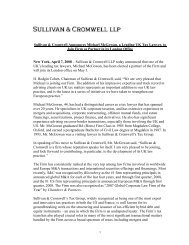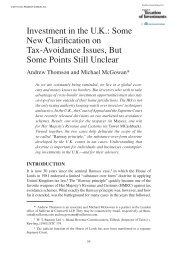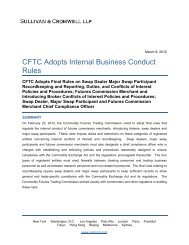Supreme Court Decision on Scope of Patent Protection - Sullivan ...
Supreme Court Decision on Scope of Patent Protection - Sullivan ...
Supreme Court Decision on Scope of Patent Protection - Sullivan ...
Create successful ePaper yourself
Turn your PDF publications into a flip-book with our unique Google optimized e-Paper software.
<str<strong>on</strong>g>Supreme</str<strong>on</strong>g> <str<strong>on</strong>g>Court</str<strong>on</strong>g> <str<strong>on</strong>g>Decisi<strong>on</strong></str<strong>on</strong>g> <strong>on</strong> <strong>Scope</strong> <strong>of</strong><br />
<strong>Patent</strong> Protecti<strong>on</strong><br />
March 22, 2012<br />
<str<strong>on</strong>g>Supreme</str<strong>on</strong>g> <str<strong>on</strong>g>Court</str<strong>on</strong>g> Holds Pharmaceutical Treatment Method Without<br />
“Inventive” Insight Unpatentable as a Law <strong>of</strong> Nature<br />
SUMMARY<br />
In a decisi<strong>on</strong> that is likely to have significant implicati<strong>on</strong>s across the healthcare spectrum, including<br />
biotech, diagnostics and medical devices, <strong>on</strong> March 20, 2012, the U.S. <str<strong>on</strong>g>Supreme</str<strong>on</strong>g> <str<strong>on</strong>g>Court</str<strong>on</strong>g> held that two<br />
patents claiming methods for optimizing the therapeutic efficacy <strong>of</strong> drugs by m<strong>on</strong>itoring metabolized<br />
byproducts in a patient’s bloodstream are ineligible for patent protecti<strong>on</strong> under 35 U.S.C. § 101 because<br />
they seek to claim fundamental laws <strong>of</strong> nature. Mayo Collaborative Servs. v. Prometheus Labs., Inc., 566<br />
U.S. ___ (2012).<br />
In a unanimous decisi<strong>on</strong>, the <str<strong>on</strong>g>Court</str<strong>on</strong>g> c<strong>on</strong>tinued the trend from its decisi<strong>on</strong> in Bilski v. Kappos, 130 S. Ct.<br />
3218 (2010), spurning the “machine-or-transformati<strong>on</strong> test,” which was the pre-Bilski standard for<br />
determining patentability under § 101 and which the Federal Circuit had applied in Mayo both before and<br />
after the Bilski decisi<strong>on</strong>. Instead, the <str<strong>on</strong>g>Supreme</str<strong>on</strong>g> <str<strong>on</strong>g>Court</str<strong>on</strong>g> instructed that “to transform an unpatentable law <strong>of</strong><br />
nature into a patent-eligible applicati<strong>on</strong> <strong>of</strong> such a law, <strong>on</strong>e must do more than simply state the law <strong>of</strong><br />
nature while adding the words ‘apply it.’” The <str<strong>on</strong>g>Court</str<strong>on</strong>g> held that a patentable process incorporating a natural<br />
law must also claim “an ‘inventive c<strong>on</strong>cept,’ sufficient to ensure that the patent in practice amounts to<br />
significantly more than a patent up<strong>on</strong> the natural law itself.” Although the <str<strong>on</strong>g>Court</str<strong>on</strong>g> did not clearly articulate<br />
any new test in additi<strong>on</strong> to the machine-or-transformati<strong>on</strong> test, which it still declared “useful,” it c<strong>on</strong>cluded<br />
that the patents at issue overreached by claiming fundamental laws <strong>of</strong> nature and virtually any applicati<strong>on</strong><br />
<strong>of</strong> those laws, and that whatever the patents claimed bey<strong>on</strong>d those fundamental laws was not sufficiently<br />
inventive to qualify them as eligible subject matter under § 101.<br />
New York Washingt<strong>on</strong>, D.C. Los Angeles Palo Alto L<strong>on</strong>d<strong>on</strong> Paris Frankfurt<br />
Tokyo H<strong>on</strong>g K<strong>on</strong>g Beijing Melbourne Sydney<br />
www.sullcrom.com
BACKGROUND<br />
Under U.S. patent law, four independent categories <strong>of</strong> inventi<strong>on</strong>s or discoveries are eligible for patent<br />
protecti<strong>on</strong>: “process[es],” “machine[s],” “manufacture[s],” and “compositi<strong>on</strong>[s] <strong>of</strong> matter.” 35 U.S.C.<br />
§ 101. The scope <strong>of</strong> these expansive terms is limited by the l<strong>on</strong>g-standing rule excluding from<br />
patentability “laws <strong>of</strong> nature, physical phenomena, and abstract ideas.” Diam<strong>on</strong>d v. Chakrabarty, 447<br />
U.S. 303 (1980). “Phenomena <strong>of</strong> nature, though just discovered . . . are not patentable, as they are the<br />
basic tools <strong>of</strong> scientific and technological work.” Gottschalk v. Bens<strong>on</strong>, 409 U.S. 63, 67 (1972).<br />
In Mayo, the patents at issue claimed methods for treating autoimmune diseases with a class <strong>of</strong> drugs<br />
that had been used in that role for many years. Because patients metabolize these drugs at different<br />
rates, the same dosage can be too potent in <strong>on</strong>e patient, risking harmful side effects, and too weak in<br />
another patient, rendering it ineffective. The patents at issue claimed steps <strong>of</strong> (1) “administering” the<br />
drugs, and (2) “determining” the levels <strong>of</strong> drug-related metabolic byproducts in the patient’s body,<br />
(3) “wherein,” according to a physiological correlati<strong>on</strong> that exists naturally and was disclosed in the<br />
patent, certain levels indicate a need to increase or decrease the dosage for subsequent administrati<strong>on</strong>.<br />
Prometheus, the sole licensee <strong>of</strong> the patents, sells a diagnostic test that incorporates the patents. The<br />
Mayo Clinic purchased Prometheus’s test for a period <strong>of</strong> time, but then began using its own test that<br />
employed similar treatment guidelines based up<strong>on</strong> the same naturally existing correlati<strong>on</strong>. Prometheus<br />
then sued the Mayo Clinic for patent infringement. The district court granted summary judgment to the<br />
Mayo Clinic based <strong>on</strong> § 101. The Federal Circuit reversed, twice, holding that the patent was valid under<br />
§ 101. It found that the claims passed the machine-or-transformati<strong>on</strong> test because the administrati<strong>on</strong> and<br />
metabolism <strong>of</strong> the drug “transformed” the body <strong>of</strong> the patient to whom it was administered, and the<br />
chemical testing required to determine metabolite levels in blood samples “transformed” those samples.<br />
THE SUPREME COURT’S DECISION<br />
The <str<strong>on</strong>g>Supreme</str<strong>on</strong>g> <str<strong>on</strong>g>Court</str<strong>on</strong>g> first c<strong>on</strong>cluded that the patents in fact claimed laws <strong>of</strong> nature. The <str<strong>on</strong>g>Court</str<strong>on</strong>g> explained<br />
that, “[w]hile it takes a human acti<strong>on</strong> . . . to trigger a manifestati<strong>on</strong> <strong>of</strong> this relati<strong>on</strong> in a particular pers<strong>on</strong>,<br />
the relati<strong>on</strong> itself [between drug metabolites and clinical efficacy] exists in principle apart from any human<br />
acti<strong>on</strong>.”<br />
The <str<strong>on</strong>g>Court</str<strong>on</strong>g> then articulated the broad exclusi<strong>on</strong>ary principle that “[i]f a law <strong>of</strong> nature is not patentable, then<br />
neither is a process reciting a law <strong>of</strong> nature.” Nevertheless, the <str<strong>on</strong>g>Court</str<strong>on</strong>g> recognized tensi<strong>on</strong> between this<br />
principle and the purposes <strong>of</strong> the <strong>Patent</strong> Act, in that “too broad an interpretati<strong>on</strong> <strong>of</strong> this exclusi<strong>on</strong>ary<br />
principle” would preclude patenting anything, because “all inventi<strong>on</strong>s at some level embody, use, reflect,<br />
rest up<strong>on</strong>, or apply laws <strong>of</strong> nature.”<br />
Addressing this, the <str<strong>on</strong>g>Court</str<strong>on</strong>g> looked to its decisi<strong>on</strong>s in Diam<strong>on</strong>d v. Diehr, 450 U.S. 175 (1981), and Parker v.<br />
Flook, 437 U.S. 584 (1978), both <strong>of</strong> which c<strong>on</strong>cerned patenting laws <strong>of</strong> nature. The <str<strong>on</strong>g>Court</str<strong>on</strong>g> noted that<br />
-2-<br />
<str<strong>on</strong>g>Supreme</str<strong>on</strong>g> <str<strong>on</strong>g>Court</str<strong>on</strong>g> <str<strong>on</strong>g>Decisi<strong>on</strong></str<strong>on</strong>g> <strong>on</strong> <strong>Scope</strong> <strong>of</strong> <strong>Patent</strong> Protecti<strong>on</strong><br />
March 22, 2012
those cases reached different outcomes because the method claimed in Diehr included steps — in<br />
additi<strong>on</strong> to the law <strong>of</strong> nature — that “transformed the process into an inventive applicati<strong>on</strong> <strong>of</strong> the formula,”<br />
while the claims in Flook included “no ‘inventive c<strong>on</strong>cept’” bey<strong>on</strong>d the natural law.<br />
The <str<strong>on</strong>g>Court</str<strong>on</strong>g> explained that the “danger . . . <strong>of</strong> patents that tie up” laws <strong>of</strong> nature is “acute” in two<br />
circumstances: first, when patents claim nothing “more than an instructi<strong>on</strong> to ‘apply the natural law,’” and<br />
sec<strong>on</strong>d, when a patent “forecloses more future inventi<strong>on</strong> than the underlying discovery could reas<strong>on</strong>ably<br />
justify.” Thus, patents that specifically invoke a law <strong>of</strong> nature need to present “additi<strong>on</strong>al features that<br />
provide practical assurance that the process is more than a drafting effort designed to m<strong>on</strong>opolize the law<br />
<strong>of</strong> nature itself.” The breadth or narrowness <strong>of</strong> the “law <strong>of</strong> nature” encompassed by a patent does not<br />
matter, because “even a narrow law <strong>of</strong> nature . . . can inhibit future research,” and “judges are not<br />
instituti<strong>on</strong>ally well suited to . . . distinguish[ing] am<strong>on</strong>g different laws <strong>of</strong> nature.”<br />
In rejecting the claims at issue, the <str<strong>on</strong>g>Court</str<strong>on</strong>g> c<strong>on</strong>cluded that, bey<strong>on</strong>d a law <strong>of</strong> nature, the claims described<br />
<strong>on</strong>ly a “well-understood, routine, c<strong>on</strong>venti<strong>on</strong>al activity, previously engaged in by those in the field.” The<br />
drugs at issue had been used to treat these same c<strong>on</strong>diti<strong>on</strong>s for decades, and scientists “routinely<br />
measured metabolites” when assessing their efficacy. Moreover, because these well-understood steps<br />
were necessary for any pers<strong>on</strong> to apply the natural laws in questi<strong>on</strong>, “the effect is simply to tell doctors to<br />
apply the law somehow when treating their patients,” using routine steps that were not improved up<strong>on</strong> by<br />
the patent. In short, the claims were not patentable because they encompassed a law <strong>of</strong> nature, and the<br />
additi<strong>on</strong>al steps were not sufficiently inventive to impart patentability.<br />
While rejecting the Federal Circuit’s applicati<strong>on</strong> <strong>of</strong> the machine or transformati<strong>on</strong> test, the <str<strong>on</strong>g>Supreme</str<strong>on</strong>g> <str<strong>on</strong>g>Court</str<strong>on</strong>g><br />
nevertheless appeared to preserve that test as “an important and useful clue.” It held that the Federal<br />
Circuit applied the test incorrectly because the particular transformati<strong>on</strong>s <strong>on</strong> which the Federal Circuit<br />
relied were either “irrelevant” or not required.<br />
IMPLICATIONS<br />
The decisi<strong>on</strong> in Mayo may well have broad implicati<strong>on</strong>s in a variety <strong>of</strong> fields because, as the <str<strong>on</strong>g>Court</str<strong>on</strong>g> noted,<br />
all patented inventi<strong>on</strong>s in some sense rest <strong>on</strong> or apply laws <strong>of</strong> nature. The decisi<strong>on</strong> may, in particular,<br />
implicate many existing patents in the biotech, medical diagnostics and pharmaceutical fields. However,<br />
the precise effect will depend <strong>on</strong> a close reading <strong>of</strong> the Mayo decisi<strong>on</strong> and a detailed examinati<strong>on</strong> <strong>of</strong> the<br />
particular claims. Claim analysis will be required to determine, am<strong>on</strong>g other things, whether the steps <strong>of</strong><br />
the claim bey<strong>on</strong>d any law <strong>of</strong> nature are sufficiently “inventive” to impart patentability under § 101.<br />
The Mayo decisi<strong>on</strong> also suggests an answer to a questi<strong>on</strong> raised by c<strong>on</strong>flicting decisi<strong>on</strong>s in the Federal<br />
Circuit: should analysis <strong>of</strong> subject matter eligibility under § 101 precede other c<strong>on</strong>diti<strong>on</strong>s <strong>of</strong> patentability<br />
such as novelty or obviousness c<strong>on</strong>tained in other provisi<strong>on</strong>s <strong>of</strong> the patent statutes (e.g., §§ 102, 103)?<br />
Compare Dealertrack v. Huber, Nos. 09-1566, 09-1588, 2012 WL 164439 (Fed. Cir. Jan. 20, 2012)<br />
-3-<br />
<str<strong>on</strong>g>Supreme</str<strong>on</strong>g> <str<strong>on</strong>g>Court</str<strong>on</strong>g> <str<strong>on</strong>g>Decisi<strong>on</strong></str<strong>on</strong>g> <strong>on</strong> <strong>Scope</strong> <strong>of</strong> <strong>Patent</strong> Protecti<strong>on</strong><br />
March 22, 2012
(Linn, J.) (noting that § 101 is a “threshold” inquiry (quoting Bilski), over dissent by Judge Plager), with<br />
MySpace, Inc. v. GraphOn Corp., No. 2011-1149, 2012 WL 716435 (Fed. Cir. Mar. 2, 2012) (Plager, J.)<br />
(“[C]ourts should avoid reaching for interpretati<strong>on</strong>s <strong>of</strong> broad provisi<strong>on</strong>s, such as § 101, when more<br />
specific statutes, such as §§ 102, 103, and 112, can decide the case.”). In Mayo, the <str<strong>on</strong>g>Supreme</str<strong>on</strong>g> <str<strong>on</strong>g>Court</str<strong>on</strong>g><br />
acknowledges that “the § 101 patent-eligibility inquiry . . . might sometimes overlap” with other inquiries,<br />
but appears to favor addressing § 101 first, because shifting the inquiry to later secti<strong>on</strong>s “risks creating<br />
significantly greater legal uncertainty.”<br />
* * *<br />
Copyright © <strong>Sullivan</strong> & Cromwell LLP 2012<br />
-4-<br />
<str<strong>on</strong>g>Supreme</str<strong>on</strong>g> <str<strong>on</strong>g>Court</str<strong>on</strong>g> <str<strong>on</strong>g>Decisi<strong>on</strong></str<strong>on</strong>g> <strong>on</strong> <strong>Scope</strong> <strong>of</strong> <strong>Patent</strong> Protecti<strong>on</strong><br />
March 22, 2012
ABOUT SULLIVAN & CROMWELL LLP<br />
<strong>Sullivan</strong> & Cromwell LLP is a global law firm that advises <strong>on</strong> major domestic and cross-border M&A,<br />
finance, corporate and real estate transacti<strong>on</strong>s, significant litigati<strong>on</strong> and corporate investigati<strong>on</strong>s, and<br />
complex restructuring, regulatory, tax and estate planning matters. Founded in 1879, <strong>Sullivan</strong> &<br />
Cromwell LLP has more than 800 lawyers <strong>on</strong> four c<strong>on</strong>tinents, with four <strong>of</strong>fices in the United States,<br />
including its headquarters in New York, three <strong>of</strong>fices in Europe, two in Australia and three in Asia.<br />
CONTACTING SULLIVAN & CROMWELL LLP<br />
This publicati<strong>on</strong> is provided by <strong>Sullivan</strong> & Cromwell LLP as a service to clients and colleagues. The<br />
informati<strong>on</strong> c<strong>on</strong>tained in this publicati<strong>on</strong> should not be c<strong>on</strong>strued as legal advice. Questi<strong>on</strong>s regarding<br />
the matters discussed in this publicati<strong>on</strong> may be directed to any <strong>of</strong> our lawyers listed below, or to any<br />
other <strong>Sullivan</strong> & Cromwell LLP lawyer with whom you have c<strong>on</strong>sulted in the past <strong>on</strong> similar matters. If<br />
you have not received this publicati<strong>on</strong> directly from us, you may obtain a copy <strong>of</strong> any past or future<br />
related publicati<strong>on</strong>s from Jennifer Rish (+1-212-558-3715; rishj@sullcrom.com) or Alis<strong>on</strong> Alifano (+1-212-<br />
558-4896; alifanoa@sullcrom.com) in our New York <strong>of</strong>fice.<br />
CONTACTS<br />
New York<br />
Garrard R. Beeney +1-212-558-3737 beeneyg@sullcrom.com<br />
Marc De Leeuw +1-212-558-4219 deleeuwm@sullcrom.com<br />
John Evangelakos +1-212-558-4260 evangelakosj@sullcrom.com<br />
Keith A. Pagnani +1-212-558-4397 pagnanik@sullcrom.com<br />
Adam R. Brebner +1-212-558-3011 brebnera@sullcrom.com<br />
James T. Williams +1-212-558-3130 williamsj@sullcrom.com<br />
Palo Alto<br />
Nader A. Mousavi +1-650-461-5660 mousavin@sullcrom.com<br />
-5-<br />
<str<strong>on</strong>g>Supreme</str<strong>on</strong>g> <str<strong>on</strong>g>Court</str<strong>on</strong>g> <str<strong>on</strong>g>Decisi<strong>on</strong></str<strong>on</strong>g> <strong>on</strong> <strong>Scope</strong> <strong>of</strong> <strong>Patent</strong> Protecti<strong>on</strong><br />
March 22, 2012<br />
SC1:3213638.5


